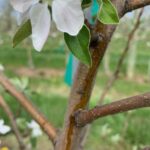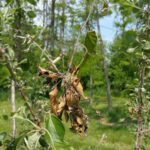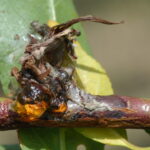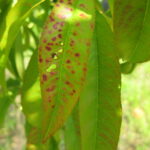Fire blight, caused by the bacterium Erwinia amylovora, is a devastating disease of apples and pears. Epidemics of the disease develop quickly, particularly in a climate of warm, wet weather like this weekend! The type of management program developed by each orchard will vary considerably based upon a variety of orchard factors, including apple variety, rootstock, age of planting, and weather conditions. With the current climate of extreme wet weather throughout the state, a review of fire blight seems timely.
If you get nothing else from this post, please know that if you have a history of fire blight, or have fire blight susceptible varieties (Jonathan, Gala, Fuji, etc.), the application at king bloom followed by a second application a few days later (bloom through petal fall) is essential to protecting trees, especially young trees! To date, we have not identified any streptomycin -resistant fire blight bacteria in Indiana. With proper stewardship, we can do a lot to keep it that way. Apply streptomycin with the first (king) bloom, followed by full bloom and possibly petal fall, depending how quickly flowers cycle through bloom to petal fall.
For those at tight cluster through pink: Assuming trees have less than 3” of new growth, early applications of apogee will help prevent fire blight in what is shaping up to be another challenging year.
Fire blight infections start primarily at the flowers, although bacteria can enter and establish through wounds caused by hail or high winds associated with summer storms (referred to as shoot blight or trauma blight. Note: shoot blight is often the result of carryover flower infections from the previous year). How much the bacteria spread has a lot to do with type of cultivar infected: Red Delicious, Honeycrisp, McIntosh, and Empire are more resistant to fire blight, compared to cultivars like Crispin (Mutsu), Fuji, Gala, Ginger Gold, Gravenstein, Jonathan, Ida Red, and Lodi that are much more susceptible. How much the bacteria spread also has a lot to do with the age of the tree, with younger trees more susceptible than older ones. Finally, excessive N fertilization, especially if ammoniacal nitrogen is used, can make even ‘resistant’ cultivars susceptible to fire blight.
Susceptible cultivars serve as reservoirs for the fire blight bacteria. Years ago, at our research plot at Meigs, we witnessed a severe outbreak of fire blight in the Fuji/Gala/Jonathan/Ruby Jon planting. This block of super susceptible cultivars acted as a source of inoculum for other cultivars, quickly spreading throughout the block, and then radiating out to those trees adjacent to or downwind from the Fuji/Gala/Jonathan/Ruby Jon planting. Please use our hard earned wisdom to avoid these problems in your own orchard!
If your orchard has a history of fire blight, I would strongly encourage you to consider applying Apogee or Kudos(Prohexadione-Ca). Apogee is a growth regulator that does not directly kill the fire blight bacterium, but reduces shoot growth and vigor, thereby increasing plant resistance. Apogee suppresses apple shoot growth when applied near petal fall as a single spray, or as several applications over time. Apple response to Apogee depends upon the cultivar, timing, rate of application, crop load, and even geographical location (This is all covered in the spray guide, pp. 47-49 in the Midwest Fruit Pest Management Guide ). Regardless of this variability, Apogee remains the best management tool available for controlling the shoot blight phase of fire blight that growers may be faced with after a freeze.
Finally, unless you are still at bloom, streptomycin use is not recommended. Its efficacy (along with the plant growth regulator, Apogee) is restricted to use at bloom, followed up once or twice through petal fall. No antibiotic is recommended for trauma blight. In Indiana, where there are no reports of streptomycin resistant fire blight bacteria, there is no need to use any other antibiotic.
- Figure 1. Possible ooze at bloom.
- Figure 2. Fire blight crook and canker.
Stone Fruit
Fire blight isn’t the only problem affecting blooms. Brown rot blossom blight never sleeps, and is particularly active under wet, moderate temperatures, like we have now. For those of you lucky enough to still have peaches and other stone fruit, be sure to protect your crop with iprodione (Rovral, Meteor) at bloom. Do not apply iprodione after petal fall.
To control blossom rot and peach scab at shuck split, I like a final application of Bravo Weatherstik (FRAC M), but other options include FRAC 11 (Abound; FRAC 7-11 Luna Sensation, Merivon or Pristine); FRAC 1(Topsin M) with or without captan; and FRAC 3(Indar, Inspire Super, Rhyme, Topguard Specialty Crop) or the premix Topguard EQ (FRAC 3+11). FRAC 3 fungicides improve powdery mildew management, if you are struggling with PM control.
Finally, if bacterial spot has been a problem, apply fire line or mycoshield at 7-day intervals from petal fall/shuck split to first cover. Avoid copper if the conditions are wet, and see the Midwest Fruit Pest Management Guide for more information.
- Figure 3. Brown rot blossom blight. Photo by Norm Lalancette, Rutgers University.
- Figure 4. Bacterial spot/shot hole of stone fruit.



